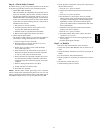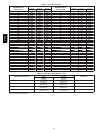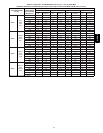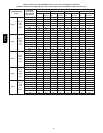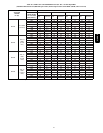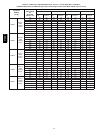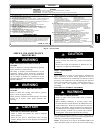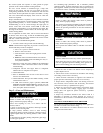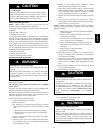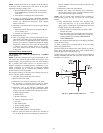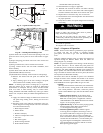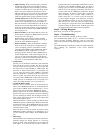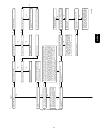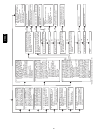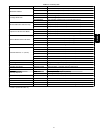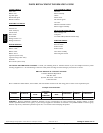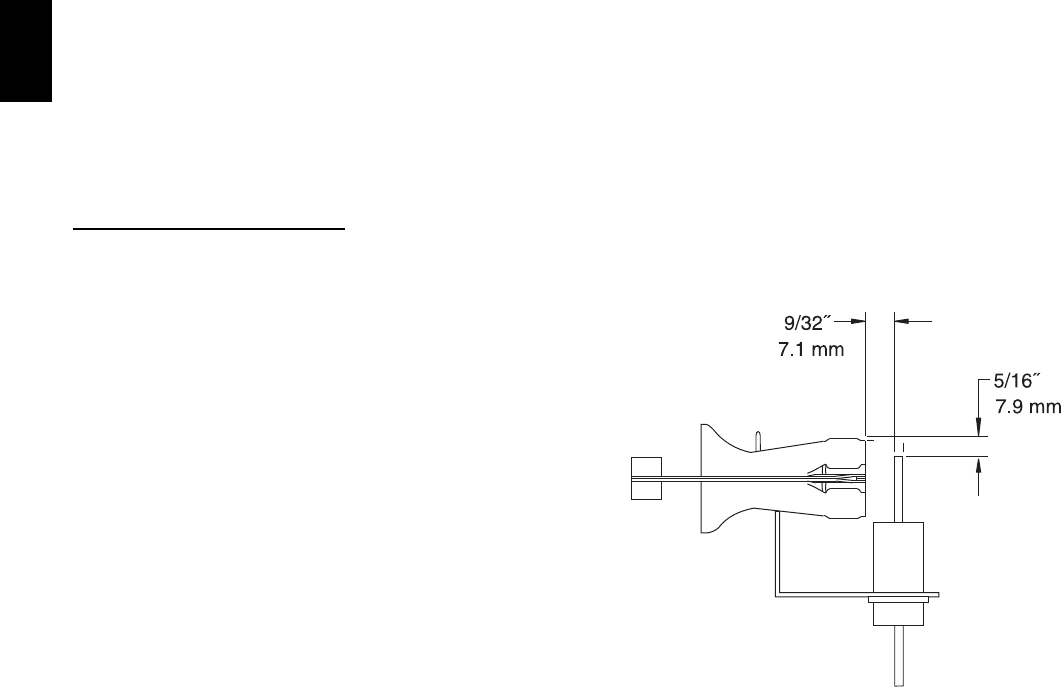
46
NOTE: If thermostat terminals are jumpered at the time blower
access door switch is closed, blower will run for 90 sec before
beginning a heating or cooling cycle.
c. Perform component self--test as shown at the bottom
of the SERVICE label, located on the front of blower
access door.
d. Verify blower is rotating in the correct direction
16. If furnace is operating properly, RELEASE BLOWER
ACCESS DOOR SWITCH. Remove any jumpers or re-
connect any disconnected thermostat leads. Replace
blower access door.
17. Downflow or horizontal furnaces with vent pipe through
furnace only:
a. Install and connect short piece of vent pipe inside fur-
nace to existing vent.
b. Connect vent connector to vent elbow.
18. Reinstall casing door.
19. Turn on gas supply and cycle furnace through one com-
plete heating and cooling cycle. Verify the furnace temper-
ature rise as shown in Adjustments Section. Adjust tem-
perature rise as shown in Adjustments Section. If outdoor
temperature is below 70_F, (21_C) turn off circuit breaker
to outdoor unit before running furnace in the cooling
cycle. Turn outdoor circuit breaker on after completing
cooling cycle.
CLEANING HEAT
EXCHANGER
The following steps should be performed by a qualified
service agency:
NOTE: If the heat exchangers get a heavy accumulation of soot
and carbon, they should be replaced rather than trying to clean
them thoroughly. A heavy build--up of soot and carbon indicates
that a problem exists which needs to be corrected, such as
improper adjustment of manifold pressure, insufficient or poor
quality combustion air, incorrect size or damaged manifold
orifice( s), improper gas, or a restricted heat exchanger. Action
must be taken to correct the problem.
If it becomes necessary to clean the heat exchangers because of
dust or corrosion, proceed as follows:
1. Turn OFF gas and electrical power to furnace.
2. Remove outer access door.
3. Disconnect vent connector from furnace vent elbow.
4. For downflow or horizontal furnace having an internal
vent pipe, remove internal vent pipe within the casing.
5. Disconnect wires to the following components. Mark
wires to aid in reconnection of (be careful when discon-
necting wires from switches because damage may occur):
a. Draft safeguard switch.
b. Inducer motor.
c. Pressure switch(es).
d. Limit overtemperature switch.
e. Gas valve.
f. Hot surface igniter.
g. Flame--sensing electrode.
h. Flame rollout switches.
i. Remove NOx baffles on low NOx models.
6. Remove screws that fasten the collector box assembly to
the cell panel. Be careful not to damage the collector box.
Inducer assembly and elbow need not be removed from
collector box.
7. Disconnect gas line from gas manifold.
8. Remove the 5 screws that attach the burner assembly to
the cell panel. The gas valve and individual burners need
not be removed from support assembly.
NOTE: Be very careful when removing burner assembly to
avoid breaking igniter. See Fig. 46 and 47 for correct igniter
location.
9. Using field--provided 25--caliber rifle cleaning brush,
36--in. (914 mm) long, 1/4 in. (6 mm) diameter steel
spring cable, a variable speed, reversible electric drill, and
vacuum cleaner, clean cells as follows:
a. Remove metal screw fitting from wire brush to allow
insertion into cable.
b. Insert the twisted wire end of brush into end of spring
cable, and crimp tight with crimping tool or crimp by
striking with ball--peen hammer. TIGHTNESS IS
VERY IMPORTANT.
NOTE: The materials needed in item 9 can usually be purchased
at local hardware stores.
(1) Attach variable--speed, reversible drill to the end of spring
cable (end opposite brush).
(2) Insert brush end of cable into the outlet opening of cell and
slowly rotate with drill. DO NOT force cable. Gradually insert
cable into upper pass of cell. (See Fig. 48.)
(3) Work cable in and out of cell 3 or 4 times to obtain sufficient
cleaning. DO NOT pull cable with great force. Reverse drill and
gradually work cable out.
A05025
Fig. 46 --- Igniter Position--Side View
310AAV



